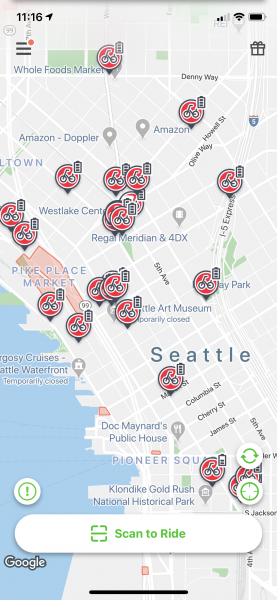Geekwire: Lime is adding another 1,500 JUMP bikes in Seattle, bikes now available in Lime app

Read JUMP bikes can now be checked out via the Lime app.
If you have been having trouble finding a bright red shared JUMP bike around town, relief may be on the way. Lime is planning to quadruple the number of shared e-bikes on Seattle streets from 500 to 2,000 by the end of summer, Geekwire reports.
Lime acquired JUMP in a complicated investment scheme with Uber back in May (wow, that really wasn't very long ago but it sure feels like an eternity). After Seattle went about a month with no bikes available, Lime launched 500 JUMP bikes in June that were only available for checkout via the Uber app. Now Lime seems to have JUMP fully integrated into its system and is ready to start expanding.
But Lime's Director of Strategic Development Jonathan Hopkins told Geekwire something the company has been saying a lot recently: The bikes are not a viable business on their own. Lime needs Seattle to allow scooters in addition to bikes in order to make it all pencil out.
The era of private bike share companies and investors losing money to prop up their services may be coming to a close. Scooters have been shown to be more profitable (or at least closer to profitable), though a scooter and a bike are also used in different ways. Lime says they hope to be able to balance both, though with more scooters than bikes. Seattle's scooter permit has been in process for a long time but is still in limbo.
The incredible roller coaster of a private bike share experiment in Seattle in recent years has taught us so much about the benefits of bike share and the costs associated with it. Bike ridership increased steeply along with bike share, and it continued to climb even as the number of bikes in service decreased or stayed flat. The combination of building new protected bike routes and the availability of on-demand bikes was a clear success, at least from the perspective of a city with transportation, public health and environmental goals that all include increasing bike ridership.
Just because businesses have struggled to make bike share profitable does not mean the experiment has failed. I mean, if you're a venture capitalist who didn't get the big return you were hoping for, then yeah, I guess it might have failed. But for the rest of us, we now have a good idea of how many bikes are needed, the benefits and pitfalls of the dockless model, the benefits and challenges of e-bikes compared to pedal-only bikes, and roughly how much subsidy would be needed to run a stable system.
We hope Lime can make this work. Scooters somewhat covering the losses of bikes is an interesting way to keep bike share active. But this system does come at a cost. Lime is charging $1 to unlock a bike plus $0.36 per minute, which is likely too expensive for many people (you can sometimes find $0.15/min bikes if you search around in the app, but Lime said that is an error). This is a significant price hike compared to even last year, but it is likely closer to what they need to make in order to pay for the service if they were to rely on user fees. $0.36 per minute adds up fast, with total bike trip costs surpassing the cost of a pre-COVID transit fare after just five minutes of riding. A lot of people simple cannot afford that, especially right now.
So it seems clear that some other funding source is needed to make a bike share system work, whether that is public funding, on-bike advertising, major sponsorships, being paired with a more profitable venture like scooters, or some other idea we haven't seen yet. The benefits of bike share are huge and worthwhile, so I hope everyone continues to try new things in search of a sustainable model.